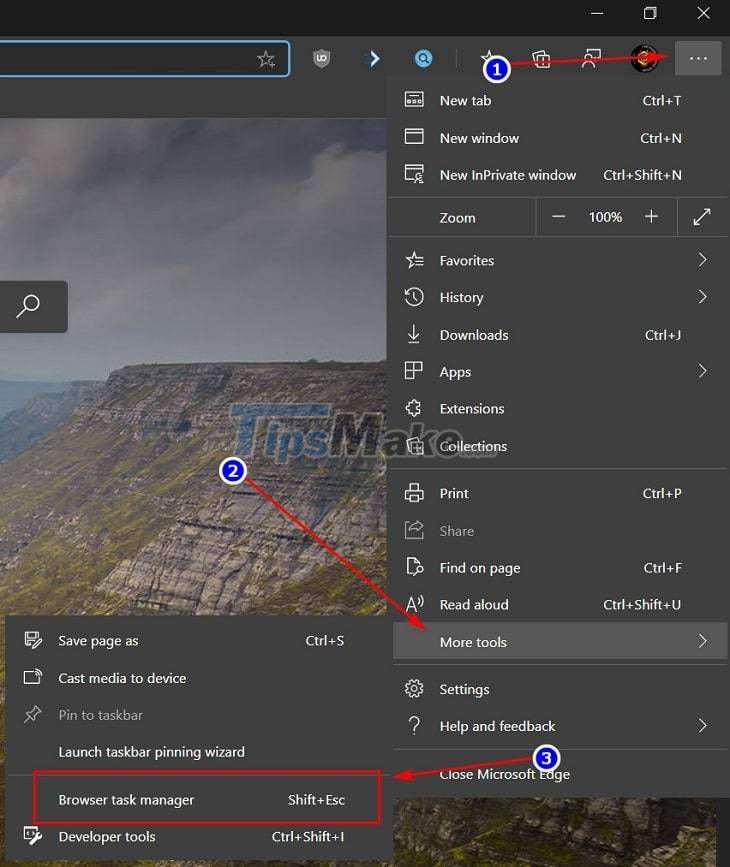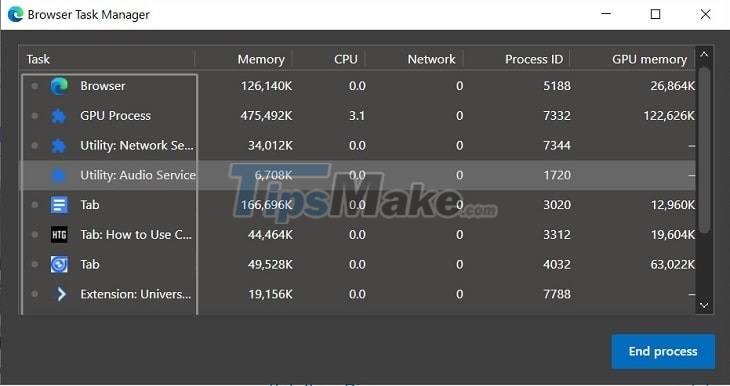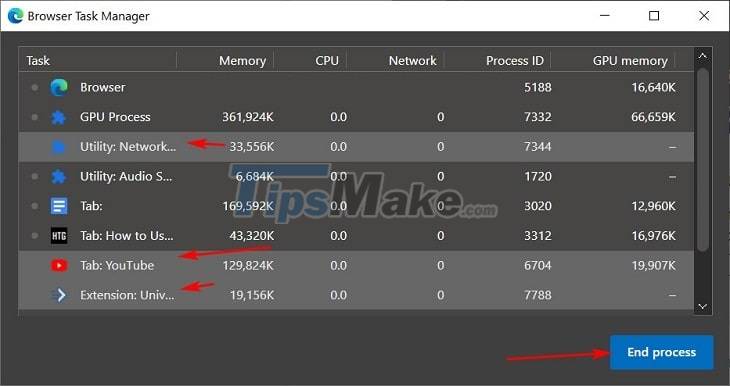How to use Task Manager of Microsoft Edge, Google Chrome
Each operating system is equipped with its own task manager, or we often call it with the familiar name Task Manager => to help users view and manage running tasks and services. on the operating system.
I think many of you will not know, or not notice that the web browser Google Chrome or Microsoft Edge Chromium that we are using is also equipped with a task manager of its own.
And so that you can more easily manage the amount of resources that the web browser is using, in this article, I will show you in detail how to use Google Chrome's own Task Manager, Microsoft Edge Chromium !
Instructions for using Chrome's Task Manager or Edge Chromium
The fact that Google Chrome or web browsers in general has Task Manager is a great thing, it allows you to manage the hardware resources that this browser has used in a more intuitive and easy way.
If before, you only knew that Chrome was consuming a lot of your computer's RAM but could not know exactly what component on Chrome was causing it, now.
…. With the built-in Task Manager on the web browser, we will see exactly what utilities and tabs are constantly consuming the computer's RAM.
And because it uses the same Chromium core, when Chrome has it, Microsoft Edge Chromium or Coc Coc . also has this tool, which is also the reason why in this article I will use Edge Chromium browser to write articles, not right Chrome.
#first. How to open Task Manager on Chrome or Edge Chromium
Before learning how to use it, the first step is to know how to access the Task Manager on Edge Chromium or Google Chrome first.
And also note that on Edge Chromium, how to do it for Chrome, you do the same thing.
Method 1: First, the most basic way is to click on More Options (Three horizontal dots with Edge and 3 vertical dots on Chrome)
Next, click More Tools => and immediately you will see the words Browse task manager or Task Manager on Chrome => you click on it to open the Task Manager of Edge, Chrome.

Method 2: In addition, you can also open it faster with keyboard shortcuts like Windows' Task Manager, but instead of using all 3 keys, Ctrl + Shift + Esc, you just need to press Shift + ESC or key combination Search + ESC on ChromeBook is fine.
=> The Task Manager window of the web browser immediately appears, its interface is also quite familiar and not too difficult to get used to and use.
The center is still a list showing Tabs, active utilities, and the amount of hard disk resources such as RAM, CPU, GPU, . that they occupy, and add some other parameters such as CPU Time, GDI Handles , USER Handles, Scripts Cache… and of course, that powerful End Task button is indispensable ٩(͡๏̮͡๏)۶

#2. Close Tabs, or Browser Extensions with Task Manager
During use, there must be many times when you encounter a situation where Tabs are frozen, or suddenly consume a lot of RAM, right?
Task Manager was born to manage Tabs and utilities running in the browser, so you can completely use it to close unresponsive tabs or utilities, tabs suddenly eat up. many system resources.
To close a Tab or any utility on Edge Chromium is like closing a task on Windows 10.
First in this window, click to select the Tab or utility you want to turn off => then click the End Process button.
In addition, you can also combine Ctrl or Shift keys with the mouse to select and close multiple tasks at the same time, saving time!

#3. View a browser task that is using system resources
When a task runs, it not only uses RAM, CPU, GPU but it also has many other types of resources, and if you are looking to see how much resources that task is using in the 20 categories that Edge Chromium has no problem.
You just need to right-click anywhere in the Task Manager window, a list of more than 20 types mentioned above will appear.
The ones with a checkmark to the left of the name => mean that it has been displayed in the Task Manager, similarly please tick the lines with a checkmark to display it in the main interface.
And if you want to undisplay a certain type of resource, also in this list, click on the name of that resource type again to undisplay it.

In addition, you can also rearrange each column of specific resource statistics to your liking => by clicking on the name of that column.
For example, when you click on the word Memory, a downward arrow will appear showing that the RAM usage statistics are sorted in order from the most to the least.
If you click again on the word Memory, it will show the opposite from the least to the most. With this little trick you can know which tabs and utilities are consuming a lot of hardware during use because by default it will be quite messy.

So I have just finished guiding you in very detail how to use Task Manager on Edge Chromium web browser, or Google Chrome already. You can apply it with all web browsers using Chromium core.
Proficient use of this tool will help you manage the amount of resources that web browsers will use more efficiently and easily than using Windows' Task Manager. Hope this article will be helpful to you. Good luck !
You should read it
- All problems about using Task Manager
- Preparing for a new Task Manager on Windows 11
- Too embarrassed, Microsoft engineers had to install Google Chrome in the middle of the presentation because Edge kept crashing
- Microsoft confidently says Edge is 'fresher' and 'more reliable' than Google Chrome
- Why does a web page on Edge spawn many Windows processes?
- Will Microsoft Edge new version be the real rival of Google Chrome? Maybe very much!
- Ways to enable Task Manager in Windows 11
- Compare Google Chrome and Microsoft Edge after improvements, which browser is better in 2018
May be interested
- 7 simple ways to open Task Manager on Macbook, Windows 10,11
 how to open task manager will help improve work efficiency and quickly handle computer problems effectively. find out with hacom here.
how to open task manager will help improve work efficiency and quickly handle computer problems effectively. find out with hacom here. - Is Google trying to convince users to 'boycott' Microsoft Edge?
 edge chromium's market share has been growing rapidly, making it one of the most promising new browser platforms available today, even considered to be able to overtake chrome in the future.
edge chromium's market share has been growing rapidly, making it one of the most promising new browser platforms available today, even considered to be able to overtake chrome in the future. - Google: 'If you want to use secure extensions, don't use Microsoft Edge'
 the new microsoft edge and google chrome are two web browser platforms with many similarities.
the new microsoft edge and google chrome are two web browser platforms with many similarities. - 6 reasons to switch to Microsoft Edge instead of using Google Chrome
 google chrome is still the world's most popular browser, but it's time to switch to microsoft edge. why? there are 6 features of microsoft edge that will make you abandon chrome once and for all.
google chrome is still the world's most popular browser, but it's time to switch to microsoft edge. why? there are 6 features of microsoft edge that will make you abandon chrome once and for all. - Microsoft Edge has added new PDF features to compete with Google Chrome
 so far, microsoft edge legacy is the best pdf reader for windows 10. chromium-based microsoft edge also comes with an excellent pdf viewer, but still lags behind legacy's version. however, microsoft is about to add new pdf features to edge, which could compete with google chrome.
so far, microsoft edge legacy is the best pdf reader for windows 10. chromium-based microsoft edge also comes with an excellent pdf viewer, but still lags behind legacy's version. however, microsoft is about to add new pdf features to edge, which could compete with google chrome. - These are all things that Edge Chromium 'imports' from Chrome
 edge chromium is a new web browser platform developed by microsoft based on google's open source chromium.
edge chromium is a new web browser platform developed by microsoft based on google's open source chromium. - Microsoft claims Edge browser performance has been significantly improved
 over the past few months, microsoft has made no secret of its ambition to try to steer and keep windows users on edge and using the web browser more often.
over the past few months, microsoft has made no secret of its ambition to try to steer and keep windows users on edge and using the web browser more often. - Fix Microsoft Edge using RAM on Windows 10
 the new microsoft edge uses the same chromium kernel as google chrome. therefore, the browsing speed and performance of edge has been greatly improved.
the new microsoft edge uses the same chromium kernel as google chrome. therefore, the browsing speed and performance of edge has been greatly improved. - Top 10 tips for using Task Manager in Windows 10
 task manager is an extremely convenient application built in by microsoft on windows 10 to help users monitor and control the activities happening on your computer.
task manager is an extremely convenient application built in by microsoft on windows 10 to help users monitor and control the activities happening on your computer. - Former Microsoft employee revealed the secret in Task Manager on Windows 10
 since its launch in 1995, task manager has become an integral part of windows.
since its launch in 1995, task manager has become an integral part of windows.










 Steps to view saved credit cards in Google Chrome
Steps to view saved credit cards in Google Chrome Tired of Microsoft, Mozilla decided to 'hack' Windows 10
Tired of Microsoft, Mozilla decided to 'hack' Windows 10 Microsoft Edge browser has the ability to bring you back to where you were reading a PDF file
Microsoft Edge browser has the ability to bring you back to where you were reading a PDF file Discovered seven extremely serious security holes in Google Chrome
Discovered seven extremely serious security holes in Google Chrome 7 best Chrome extensions to increase your productivity
7 best Chrome extensions to increase your productivity Image of the first day of web browsers 199x
Image of the first day of web browsers 199x